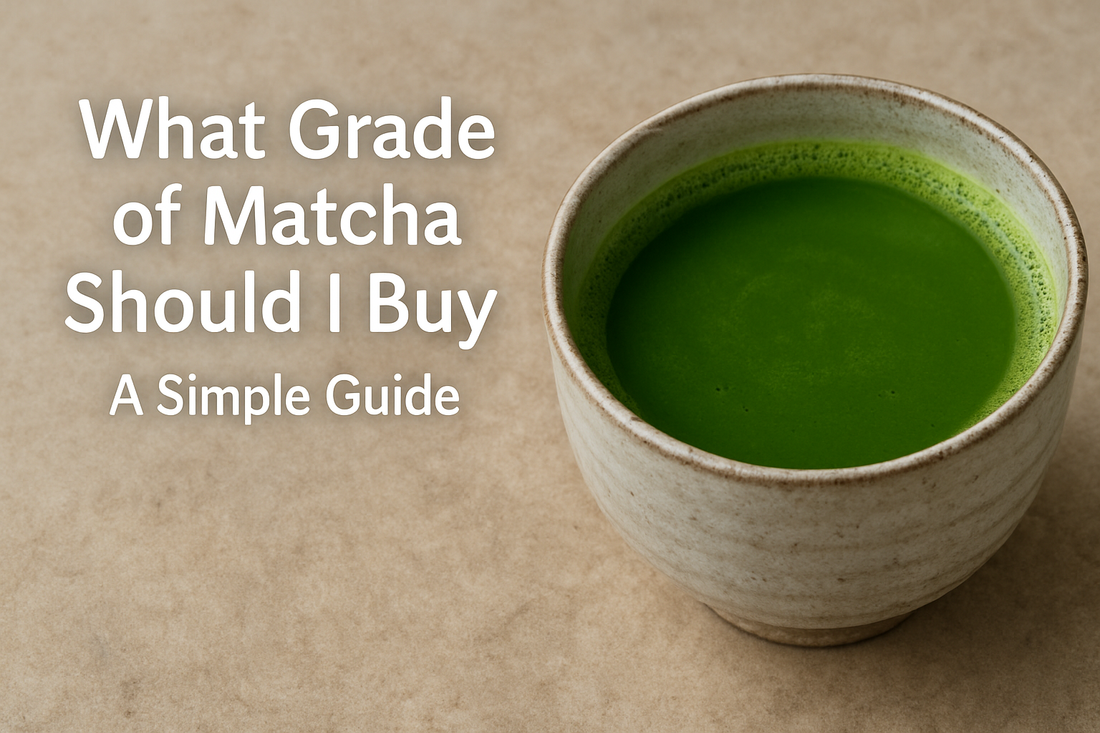
What Grade of Matcha Should I Buy? A Simple Guide
What Is Matcha, Really?
Let’s start with the basics — matcha is green tea, but way more powerful. Unlike regular green tea where you steep the leaves and throw them away, matcha is made by grinding the whole tea leaf into a fine powder — and you drink all of it! So you’re getting all the nutrients, flavor, and energy in one cup.
Imagine drinking a smoothie made from whole fruits vs. just drinking fruit-flavored water — that’s the difference between matcha and regular tea.

🍃 How Is Matcha Grown and Harvested?
Matcha comes from a special type of green tea plant called Tencha, and the way it’s grown makes all the difference:
-
Shading the Tea Leaves (Yes, They Get Covered!)
A few weeks before harvest, farmers cover the tea plants with shade cloths to block the sunlight. This helps the leaves produce more chlorophyll (that bright green color!) and L-theanine (a calming amino acid). -
Hand-Picking Only the Best Leaves
Only the youngest, softest top leaves are picked by hand for high-quality matcha. Older leaves go into lower grades or are used for other types of tea. -
Steaming & Drying
The leaves are then steamed (to stop fermentation), dried, and the stems and veins are removed — leaving behind only the soft leaf part. -
Stone-Grinding Into Fine Powder
Finally, the leaves are stone-ground very slowly into an ultra-fine green powder — this is matcha!
Why Are There Different Matcha Grades?
Not all matcha is created equal — and that’s actually a good thing! Different matcha grades serve different purposes.

Matcha is generally divided into 3 main types:
🥇 1. Ceremonial Grade Matcha
Use for: Drinking straight with hot water (the traditional Japanese way)
Flavor: Naturally sweet, smooth, no bitterness
Color: Vibrant, glowing green 🌿
This is the highest quality matcha – made from the youngest and most tender top leaves. It's soft, creamy, and perfect for sipping on its own with hot water. It’s like the matcha used in traditional Japanese tea ceremonies.
Best for: Meditation, slow mornings, skincare routines, and anyone who wants the purest matcha experience.
💡 How to prepare: Whisk with hot (not boiling) water using a bamboo whisk (chasen) until frothy and creamy.
🥈 2. Premium Grade Matcha
Use for: Matcha lattes, iced matcha, or drinking with water/milk
Flavor: Smooth, slightly bold, mild bitterness
Color: Deep green
Premium matcha is your everyday hero — great for mixing with milk or drinking as a tea. It's not as delicate as ceremonial grade, but still has a balanced flavor and nice color.
Best for: People who love matcha daily but want it affordable and versatile.
💡 How to prepare: Add 1–2g of matcha with a bit of hot water, whisk or shake it, and pour over milk (hot or iced!).
🥉 3. Culinary Grade Matcha
Use for: Cooking, baking, smoothies, desserts
Flavor: Bold, earthy, slightly bitter
Color: Dull green or olive
Culinary matcha is stronger and meant to blend into recipes. Its bold flavor holds up well when mixed with other ingredients like milk, sugar, or flour.
Best for: Bakers, chefs, cafes, or anyone making matcha cookies, cakes, ice creams, and more.
💡 Pro tip: Use this in recipes where matcha flavor is mixed with sweetness or cream.
Quick Visual Comparison
| Grade | Color | Flavor | Best Use |
|---|---|---|---|
| Ceremonial | Vibrant Green | Sweet & Smooth | Drinking with hot water |
| Premium | Deep Green | Bold but smooth | Lattes & iced drinks |
| Culinary | Olive Green | Strong & Bitter | Cooking & baking |
So, Which One Should You Choose?
It depends on how you want to use matcha and how strong you like the taste.
-
Want to sip matcha like tea? → Go for Ceremonial Grade
-
Love daily lattes or iced matcha? → Choose Premium Grade
-
Want to cook or bake with it? → Use Culinary Grade
🧠 Still not sure? Try a Matcha Sampler Kit — we recommend tasting each grade and finding the one that suits your lifestyle and taste buds best!
🔍 Bonus: What to Look for When Buying Matcha
Make sure your matcha is:
✅ Bright green, not brownish or yellow
✅ Packed in airtight containers
✅ Fresh with harvest and expiry dates
✅ Stone-ground (not machine-ground)
🧒 Can Kids or Beginners Try Matcha?
Absolutely! Matcha is gentle and natural. Even beginners or young teens can enjoy it (with a smaller portion). You can mix it with honey, milk, or even make fun matcha popsicles!
💬 Final Thought: Matcha Is for Everyone — Just Choose What Fits You
Matcha isn't one-size-fits-all. Whether you’re making a quick smoothie, starting a tea ritual, or leveling up your baking — there's a perfect matcha grade waiting for you.
So don’t stress. Start simple. Taste, explore, and make matcha your own. 💚
